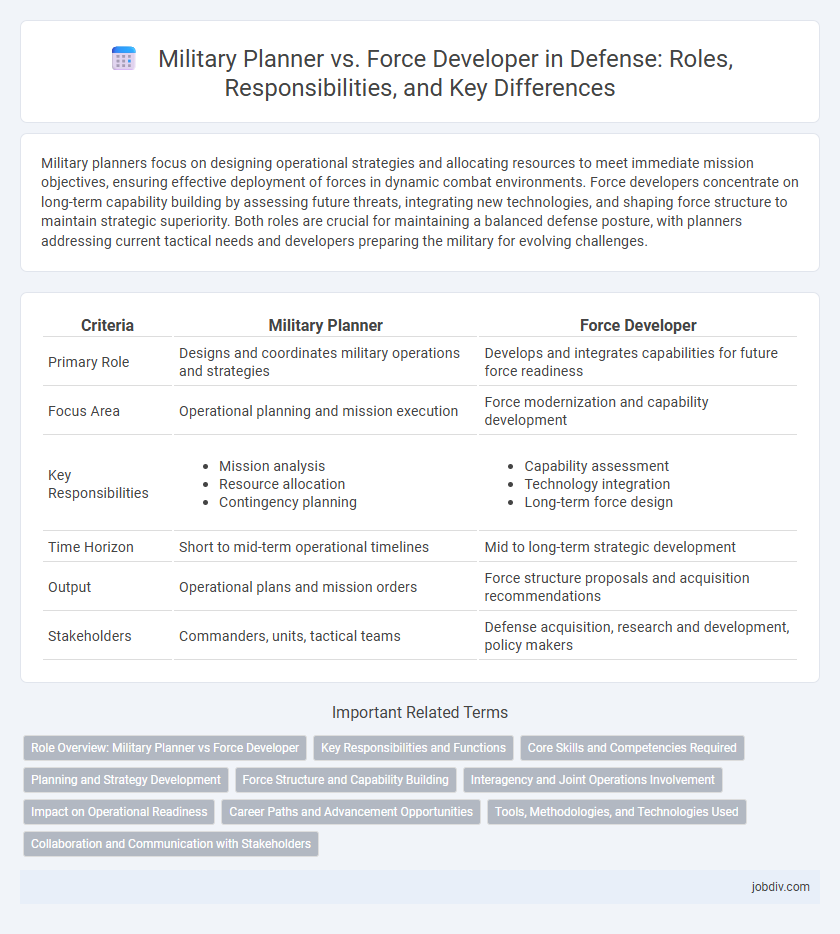Military planners focus on designing operational strategies and allocating resources to meet immediate mission objectives, ensuring effective deployment of forces in dynamic combat environments. Force developers concentrate on long-term capability building by assessing future threats, integrating new technologies, and shaping force structure to maintain strategic superiority. Both roles are crucial for maintaining a balanced defense posture, with planners addressing current tactical needs and developers preparing the military for evolving challenges.
Table of Comparison
| Criteria | Military Planner | Force Developer |
|---|---|---|
| Primary Role | Designs and coordinates military operations and strategies | Develops and integrates capabilities for future force readiness |
| Focus Area | Operational planning and mission execution | Force modernization and capability development |
| Key Responsibilities |
|
|
| Time Horizon | Short to mid-term operational timelines | Mid to long-term strategic development |
| Output | Operational plans and mission orders | Force structure proposals and acquisition recommendations |
| Stakeholders | Commanders, units, tactical teams | Defense acquisition, research and development, policy makers |
Role Overview: Military Planner vs Force Developer
Military Planners analyze operational requirements and devise strategic plans to effectively deploy forces in various combat scenarios. Force Developers focus on designing and acquiring future military capabilities, ensuring weapon systems and personnel meet evolving defense needs. Both roles collaborate to align tactical objectives with long-term force structure and technology modernization.
Key Responsibilities and Functions
Military Planners focus on operational strategy development, mission planning, and coordinating combat and support forces to meet tactical objectives. Force Developers concentrate on designing and structuring military forces, assessing capability requirements, and integrating new technologies to enhance overall combat readiness. Both roles collaborate to ensure alignment between strategic objectives and force capabilities within defense operations.
Core Skills and Competencies Required
A Military Planner requires expertise in strategic analysis, operational design, and resource allocation to develop effective campaign plans aligned with national defense objectives. Force Developers specialize in force structure optimization, capability assessment, and long-term modernization strategies to build sustainable military strength. Both roles demand strong decision-making skills, understanding of defense policy, and the ability to integrate joint, interagency, and multinational coordination.
Planning and Strategy Development
Military planners concentrate on the formulation of detailed operational plans, integrating intelligence, logistics, and mission objectives to ensure mission success. Force developers focus on shaping future military capabilities through strategic assessment, resource allocation, and modernization initiatives to maintain combat readiness. Effective defense strategy requires seamless coordination between planners' tactical frameworks and developers' long-term force structuring.
Force Structure and Capability Building
Military planners focus on designing and organizing force structure to meet strategic objectives, ensuring the allocation of resources aligns with mission requirements. Force developers specialize in capability building by identifying gaps, integrating new technologies, and shaping future force composition to enhance operational effectiveness. Collaboration between military planners and force developers is critical for maintaining a balanced, adaptive, and capable defense posture.
Interagency and Joint Operations Involvement
Military planners coordinate interagency and joint operations by integrating intelligence, logistics, and operational objectives to ensure cohesive mission execution across multiple branches and government agencies. Force developers focus on analyzing current capabilities and future threats to shape force structure, training, and resource allocation that enhance joint interoperability and interagency collaboration. Both roles are crucial for synchronizing efforts in complex defense environments, optimizing strategic outcomes in multinational and multi-agency operations.
Impact on Operational Readiness
Military planners play a critical role in shaping operational readiness by designing strategic mission plans and allocating resources to meet immediate tactical needs. Force developers focus on enhancing long-term readiness by assessing force capabilities, integrating new technologies, and shaping organizational structures to adapt to future threats. The combined efforts of military planners and force developers ensure that armed forces maintain optimal readiness levels for both current operations and evolving defense challenges.
Career Paths and Advancement Opportunities
Military Planners specialize in strategic operational planning, coordinating troop movements, and mission logistics, often advancing through roles such as Operations Officer or Tactical Planner. Force Developers focus on shaping future military capabilities, overseeing force structure, equipment modernization, and personnel readiness, with career growth typically leading to positions like Capability Manager or Defense Program Analyst. Both career paths offer advancement through joint assignments, advanced military education, and leadership roles within defense strategy and resource management.
Tools, Methodologies, and Technologies Used
Military planners utilize advanced simulation software, geospatial analysis tools, and predictive modeling to craft operational strategies and optimize resource allocation. Force developers employ capability assessment frameworks, lifecycle management systems, and emerging technologies such as artificial intelligence and machine learning to design and enhance military force structures. Both roles integrate data analytics platforms and collaborative digital environments to ensure informed decision-making and adaptive defense planning.
Collaboration and Communication with Stakeholders
Military planners coordinate closely with force developers to align strategic objectives and resource allocation, ensuring operational readiness meets defense priorities. Effective collaboration leverages real-time intelligence sharing and synchronized timelines to optimize force structure and capability enhancements. Transparent communication channels between stakeholders facilitate adaptive responses to emerging threats and evolving mission requirements.
Military Planner vs Force Developer Infographic

 jobdiv.com
jobdiv.com